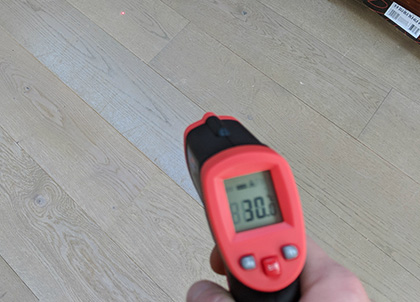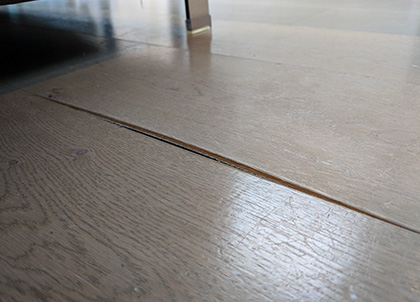Underfloor Heating & Wood Flooring: An Expert Guide
#CraftedForLife
Underfloor heating (UFH) is as popular as ever and we are very experienced at fitting wood flooring with it. Wood is totally compatible with underfloor heating and there’s nothing better than a warm feeling underfoot. However, to make sure your wooden floor’s performance and looks aren’t compromised, there are a few factors which should always be considered.

Engineered boards fitted on top of UFH
Wet and Dry UFH Systems
Wet UFH systems are connected to the central heating and tend to last longer than the electrical alternative. When used with wood flooring, the wet UFH pipework is covered with a screed or levelling compound. This provides a flat, solid surface that the wood can be glued to. Insulation is not required under the wood making the transfer of heat from the subfloor to the wood more efficient. It’s worth noting that your builder or UFH contractor is responsible for testing the system to ensure that it’s fully operational, without any leaks, before any flooring is fitted.
Dry electrical systems feature conductors or strips laid on top of the subfloor. This system requires a special underlay which can either sit underneath the UFH or on top of it. Wood flooring cannot be fixed to the subfloor, as it will puncture the heating elements. As the boards are just glued together with no surface fixing, the flooring can feel a little bouncy. This can be avoided if a levelling compound is used, as it allows the boards to be fixed to the subfloor.
Solid or Engineered Wood
This is a common question when it comes to wood flooring and UFH. As a basic rule, we advise that it’s better to use engineered flooring. That’s not to say that solid wood can’t be used, but the room’s temperature and humidity levels have to remain completely constant if solid wood is going to be used (which means that windows have to remain shut and a room’s temperature fixed), making it inconvenient and impractical for most households. Good quality engineered wood is far more reliable, as the multi-layer construction of the board makes it more robust, so it restricts movement in the wood. As with most things, you get what you pay for, so we always advise customers to source their wood flooring from a reputable supplier. To find out the importance of good quality wood flooring, read our Why Quality Wood Floors blog post.

Engineered wood features a layered plywood base which makes it very strong

Solid wood flooring is made from one solid piece of wood
Thickness of the Wood
Wood isn’t the greatest conductor of heat, so thinner boards will be able to transfer heat more efficiently than thicker boards. It is also advisable to ensure that the heat can escape. If thick rugs or pieces of furniture prevent the heat from escaping through the floor, the build up of heat can damage the floor and in some cases even burn it.

This floor had a CD rack with a metal base sitting on it, causing the wood to overheat and burn
Avoiding Potential Problems
There are potential risks when using UFH with wood flooring, which once known about, can easily be avoided. In older properties which are not particularly well insulated, the UFH will compensate for the heat loss when heating the room. This means that the heating system has to work extra hard to reach the desired room temperature. The downside of this is that in the process, the temperature of the wood floor becomes too hot. To avoid this problem, it’s a good idea to keep one or two radiators in the room, so they can contribute to the air temperature. If this isn’t an option, a thermostatic sensor can monitor the floor temperature to ensure that it doesn’t reach over the recommended temperature of 27 degrees.

At over 30 degrees, the temperature of this floor is too hot

A stylish radiator looks good and can help prevent the wood flooring from overheating
It’s also advisable to keep the UFH on during the day, so the room and floor temperature remain at a constant level. If the room isn’t adequately insulated and the heating is turned off, rooms will cool down quickly, increasing the moisture content in the house, which is then absorbed by the wood. Once the system is switched on again, it will have to work hard to reach the desired room temperature. When a wooden floor heats up quickly, the loss of moisture causes it to shrink and compress. Even with good quality engineered wood, this movement can cause gaps to appear between the boards. The consequences are far worse with badly made engineered boards. Delamination, where the top wear layer peels off from the rest of the board, can occur. We recommend the use of smart thermostats, as they will help to maintain a constant floor and room temperature throughout the day when the heating is left on. Heating costs shouldn’t increase with this method, as it take more energy to get the heating up to the desired temperature rather than keeping it ticking over.

Movement due to excessive heat in an engineered wooden floor

Measuring the moisture content in the wood floor
Insulation Requirements
The subfloor will need to be insulated for UFH. This is usually already in place in new-builds, although if the insulation is really efficient, UFH may not even be necessary. In older properties, insulation will definitely be needed. Read our Underfloor Thermal Insulation of Suspended Timber floors blog post for further information.
With a comprehensive experience fitting and restoring wood flooring, we are happy to help and advise on any queries relating to wood flooring and under floor heating. We can also point you in the right direction when it comes to finding the best wood flooring manufacturers and suppliers in London.













